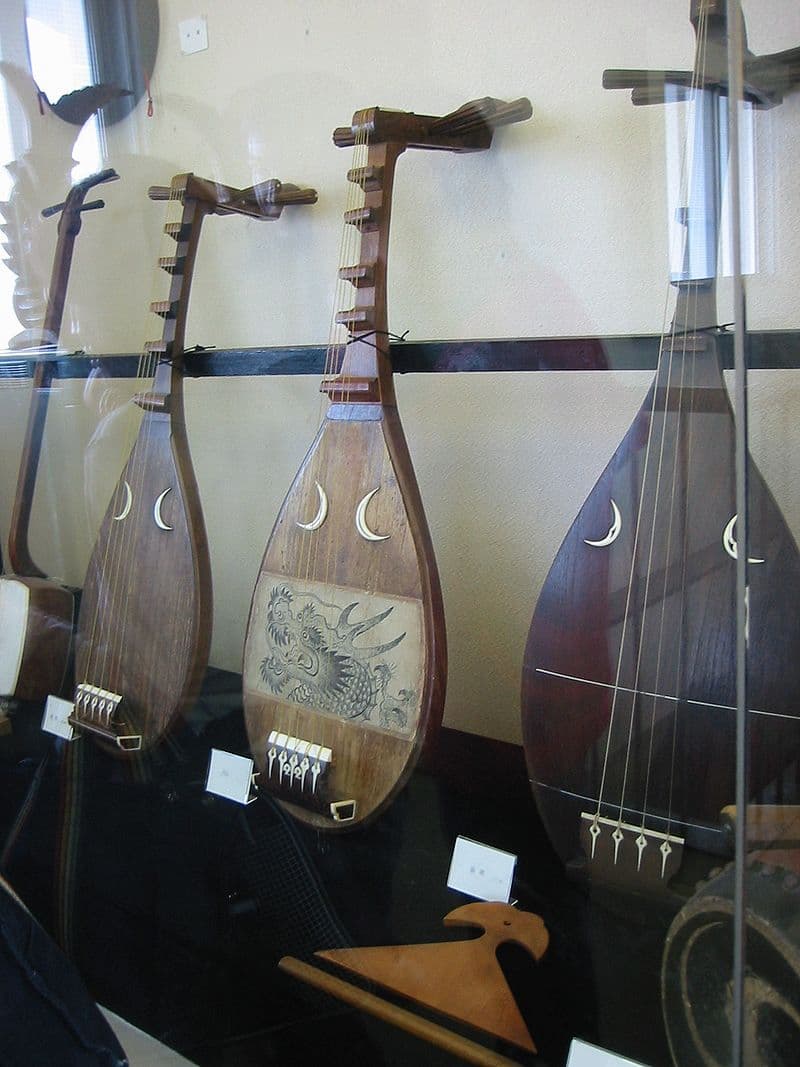One of the most famous books of Japanese literature is The Tale of Genji, written by Murasaki Shikibu in the 11th century. It is the story of Hiragu Genji, son of Emperor Kirisubo, and his life after his demotion from the line of succession. His romantic life is the focus, and it details the customs of Japan’s aristocracy at a time when Europe was in the High Idiot Ages.
Another early account of Japan’s society comes from the 13th century with The Tale of the Heike. It tells of the struggle between the Taira and the Minamoto clan for control of Japan at the end of the 12th century. The subject is the Genpei War (1180–1185). Whereas Genji is considered Japan’s first novel, Heike is more like an epic chronicle. It was passed down through the ages in the oral tradition of biwa-playing bards.

Biwa in the Gifu Castle Museum collection
The story is balanced between two points of view: the samurai and the Buddhist. Martial heroism is matched with the Buddhist idea of impermanence. The opening passage emphasizes the latter:
祇園精舎の鐘の聲、諸行無常の響き有り。 沙羅雙樹の花の色、盛者必衰の理を顯す。 驕れる者も久しからず、唯春の夜の夢の如し。 猛き者も遂には滅びぬ、偏に風の前の塵に同じ。
The sound of the Gion Shōja bells echoes the impermanence of all things; the color of the sāla flowers reveals the truth that the prosperous must decline. The proud do not endure, they are like a dream on a spring night; the mighty fall at last, they are as dust before the wind.
Chapter 1.1 (translation by Helen Craig McCullough)
Composer Daron Aric Hagen (b. 1961) has written 5 works for cello, koto, and voice based on three women of the Heike story: a nobleman’s daughter, a koto musician, and a female warrior. Hagen’s Heike Quinto. The three women, Taira no Tokushi, daughter of Kiyomori and later empress; Kogō, a beautiful and gifted koto musician; and Tomoe Gozen, a noble and brave female warrior who fought against the Heike, lived in worlds of opulence and glory but end their days as secluded nuns because of the turns of fate.

Battle scenes from The Talke of Heike, early 17th century (Adelaide, Art Gallery of South Australia)
The first two parts of the Quinto focus on Taira no Tokushi. No. 1, Appassionato, is Tokushi’s memory of the glory of her family (Before), then she describes a dream where she saw her father (During), and closes with her ascension from Earth when she’s welcomed by the Amida Buddha to the Pure Land (After).
Daron Aric Hagen: Heike Quinto No. 1, “Appassionato” – III. After (Duo YUMENO)
No. 2 is a more intimate examination of Tokushi’s character, first showing her as daughter, consort, then mother of an emperor (Without). The second movement is a portrait of her life as a nun (Cavatina), and then the third movement is her servant’s recollection of her mistress’ fall into obscurity. (Within)
Daron Aric Hagen: Heike Quinto No. 2, “Cantabile” – I. Without (Duo YUMENO)
In the third Quinto, the story tells of Kogō (portrayed by the koto) who has fled the imperial palace and is being sought by two of the emperor’s men: Takafusa, an aristocrat, and Nakakuni, a servant of the emperor (both portrayed by the cello). Nakakuni finds her after hearing her play and, taking out his flute, plays with her. After her arrest, she’s forced to become a nun.
Daron Aric Hagen: Heike Quinto No. 3, “Misterioso” – III. Kogō and Nakakuni (Duo YUMENO)
Our last heroine, Tomoe Gozen, was known for her nobility and bravery as much as for her great beauty. In the first movement, she prepares herself for the Battle of Awazu (21 February 1184), in the second movement, she tames a wild horse, and finally, in old age, she thinks back on her life.
Daron Aric Hagen: Heike Quinto No. 4, “Grandioso” – II. Horse Whispering (Duo YUMENO)
The final Quinto joins our heroines in the heavenly realm, looking down on the world and all its turmoil as they ascend to their ‘eternal state’. The recording here has the performers doubled on a pre-recorded track so that all heroines might be represented.
Daron Aric Hagen: Heike Quinto No. 5, “Apotheosis” (Duo YUMENO; Daron Aric Hagen and Tyler Ono, electronics)
It’s a remarkable set of five pieces that is both modern and ancient. The idea is from the 13th century, as is the idea of storytelling to the sound of an instrument, but it’s also modern in its mix of Eastern and Western instruments.
For more of the best in classical music, sign up for our E-Newsletter
